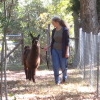| Online: | |
| Visits: | |
| Stories: |

| Story Views | |
| Now: | |
| Last Hour: | |
| Last 24 Hours: | |
| Total: | |
Agrarianism and Permaculture? My Answer
Many thanks to everyone who took the time to answer my question,
I asked the question because these things have been on my mind a lot lately. It's been something I've been mulling over quite a bit. When Dan and I bought our homestead almost five years ago, we had a strong conviction that this was something we must do. We had some skills and some experience, but it's been a journey nonetheless.
Our first five years were spent observing, planning, prioritizing, researching, building, fixing, experimenting, and learning. These years were the basis for my book, 5 Acres & A Dream The Book: The Challenges of Establishing a Self-Sufficient Homestead. In the book I referred to these first years as our “establishment phase.” Each chapter addresses a different aspect of self-sufficiency and the learning curves we've faced for each one. Our biggest challenge, however, has not been something tangible such as learning how to grow and preserve a year's worth of food, or how to get off-grid. Our biggest challenge has been our own mindset, or world view.
“By this I mean one's expectations about how things ought to be, about life and society as we are used to them. It's our attitude, particularly about what we have, what we need, and how we get it. It's our mental image about cultural and lifestyle standards, of how life ought to be lived, how things ought to work” Chapter 10, “Obstacles”
This was the focus of Chapter 10, “Obstacles,” and is the topic of a number of my blog posts (see list of related posts at the end). This is the topic that is foremost in my mind now.
Why? Because now that the master plan is fairly set, the house has received many repairs and lifestyle improvements, and proper outbuildings are in progress, it's time to think beyond getting established. It's time to draw on what we've learned and put it all together. Hence this research question, for which I turned to you. As my homesteading cyber-community, your feedback not only helps me clarify my own thoughts, but as a writer, I need to know what you think if I'm going to engage you on an intelligent level in my writing. I will blog about it every step of the way and, perhaps, this may become the basis for a sequel to 5 Acres & A Dream The Book.
It does seem true that there is more written about permaculture than agrarianism. I'm sure many know that the term permaculture first came in to use in 1978 from, “permanent agriculture”. Most simply defined, it is a design system for sustainable agriculture based on natural cycles and ecosystems. Popularly, it is used as a landscaping system in both rural and urban areas. Over the years the meaning has expanded to “permanent culture”, with the hopes that it can solve many of the world's social problems.
Agrarianism is a rather ancient concept, and hence possibly more obscured in meaning over time. Because of that it is difficult to find a definition which describes it as modern day agrarians think of it. It is often thought of as agricultural, but agriculture can take many forms, from the single family subsistence farm to the multi-billion dollar industrial farm.
Personally, I would define agrarianism as a cultural, economic, and social system based on the land, on agriculture. To further clarify, the opposite of agrarianism is not urbanism, but rather industrialism, which is based solely on money and its byproducts – consumerism and commercialism. Historically agrarianism was community based and encompassed all manner of trades and occupations. The difference was that these communities were based on a dependence on the land, rather than a dependence on money (either “real” or otherwise).
So I agree with you all that permaculture and agrarianism are not the same thing: one is a design system, the other is a cultural, economic, and social model. That does not imply incompatibility, and many agrarians do indeed practice permaculture. A permaculturist, on the other hand, may or may not be an agrarian. The CEO of a large investment firm, for example, can have an extensive permaculture landscape, but could not, as such, be an agrarian.
Is agrarianism really so arrogant as to assume superiority over any other model? How one answers that is going to depend on where one's sense of security lies. The heart of the modern agrarian movement does not see the industrial economic and social model as sustainable. It is seen as self-consuming and doomed to fail. The call for change is an attempt to extend a lifeline to anyone who wishes to grab on, before it's too late.
Those are my beginning thoughts on it, as we work toward creating a sustainable homestead. I do have more to ponder out loud and will blog about it from time to time. Please do continue the conversation with your comments. And below are a few related posts if you are interested.
Mindset: Key to Successful Homesteading?
Contemplations of Value & Money
The Lost Art of Bartering, Part 1
The Lost Art of Bartering, Part 2
“Good and Bad Investments For Farmers”
Agrarianism: Forward or Backward Thinking”
Source: http://www.5acresandadream.com/2014/03/agrarianism-and-permaculture-my-answer.html



